Photos with this report (click to enlarge) | |||
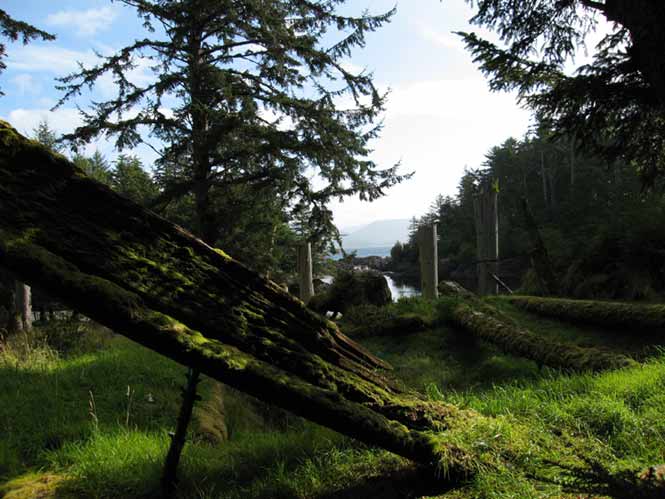 Skungwa'ai |
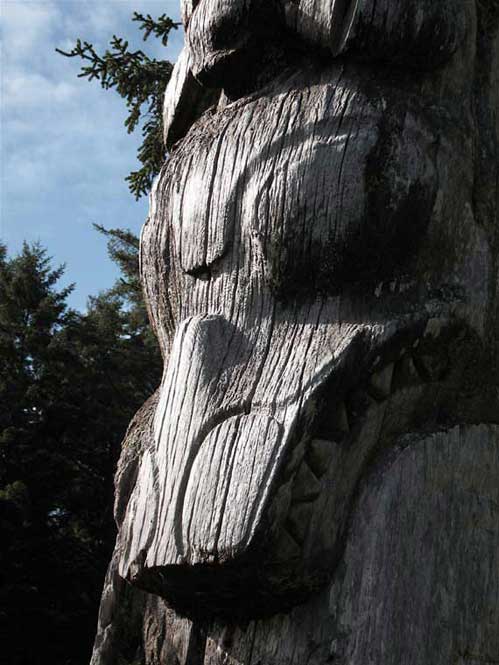 Totem at Skungwa'ai |
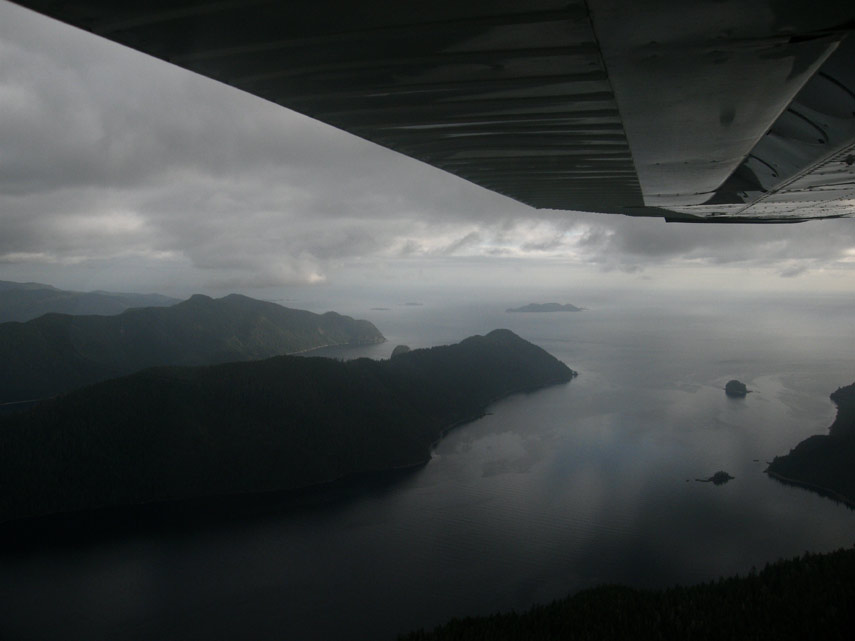 Gwaii Haanas National Paark |
|
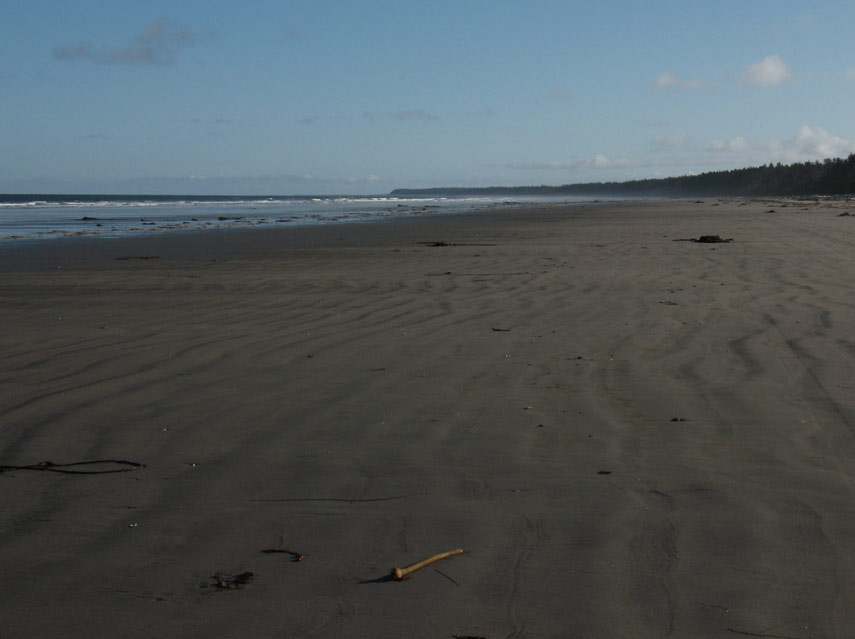 Rose Spit |
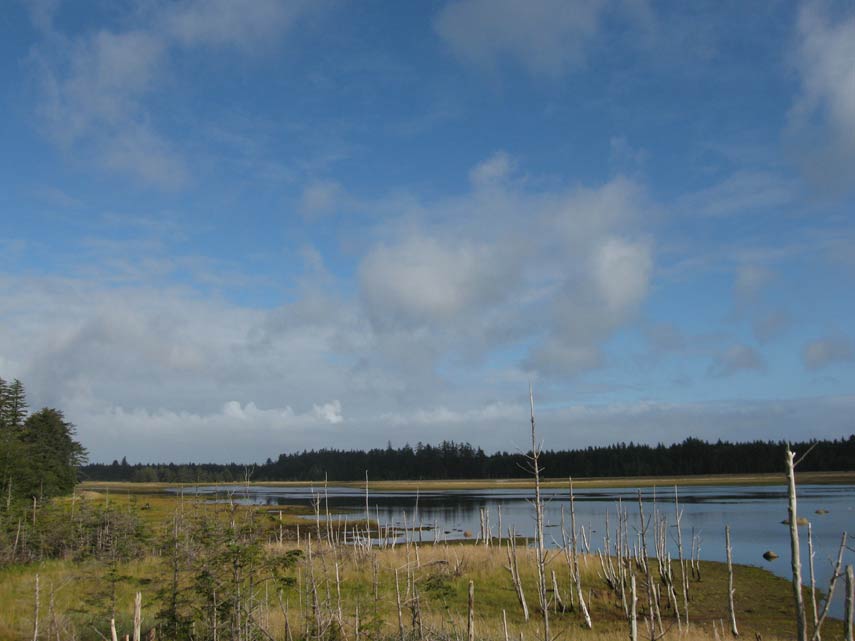 Delkatla Wildlife Reserve |
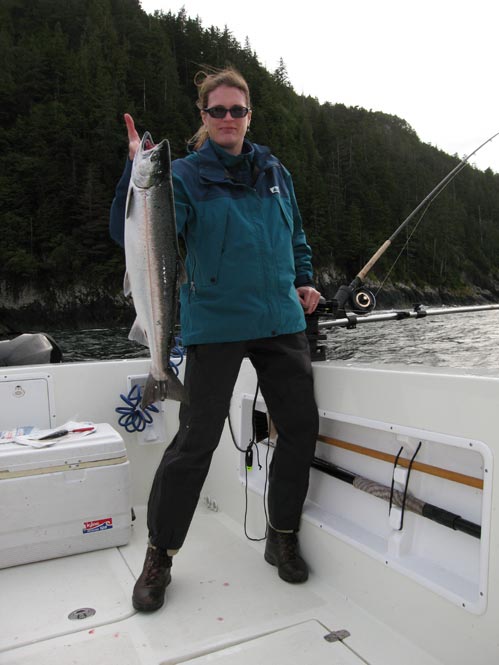 Coho |
|
My wife and I spent two weeks birding this archipelago off the British Columbia coast. We did best on pelagic species, seeing Fork-tailed Storm-Petrel and Sooty, Short-tailed, Pink-footed, Buller’s and a very rare Black-vented Shearwater. We also enjoyed the area’s spectacular scenery, rich cultural heritage and famous salmon fishing. For those wishing to see a remote and beautiful part of Canada, Haida Gwaii is definitely worth a visit.
Haida Gwaii (pronounced “Hi-da Ga-why”, land of the Haida, formerly known as the Queen Charlotte Islands) is situated off the north coast of British Columbia, near the border with Alaska. Graham is the biggest island and its main towns are Old Masset, Masset, Port Clements, Tlell, Skidegate and the village of Queen Charlotte. Below Graham is Moresby Island, location of the community of Sandspit and its airport. To the south of Moresby a spectacular chain of islands stretches into the newly protected Gwaii Haanas National Park.
The Haida are the archipelago’s original settlers. By the early 1900s smallpox reduced their number from 6,000 to less than 300. In addition to disease, Europeans also brought industrial-scale clear-cut logging, stripping huge areas of coastal rain forest bare and leaving the exposed soil to slump into the ocean.
From these depths the situation has slowly improved. The Haida have undergone a cultural and numerical renaissance and are again in ascendance on the islands. Alliances between the Haida and a broad coalition of social justice and eco-justice organizations and individuals have protected large areas of the archipelago and mitigated the most destructive logging practices. Competing visions of the past, present and future of Haida Gwaii continue, but the place remains a friendly, interesting, and sometimes exhilarating place to visit.
Getting There - Air Canada runs a daily two-hour flight from Vancouver to Sandspit. Pacific Coastal flies from Vancouver to Masset. The islands are also accessible by a seven-hour ferry journey from Prince Rupert on the mainland coast of northern British Columbia.
Getting Around - A vehicle is necessary to properly explore Graham and Moresby Islands. Most of the familiar rental agencies have desks at the airports in Sandspit and Masset, but they are expensive, charging a high rate per kilometre. We chose to go with “Rustic Rentals”, a local outfit in the village of Queen Charlotte (250 559-4641). They provided a 4X4 Jeep Cherokee at a reasonable cost and it served us well. A 4X4 is not absolutely necessary but if you want to explore the unpaved back roads you will need one, as the rental contracts for ordinary cars restrict such access.
The Island’s main paved road system runs 15 kilometres from the airport, through the town of Sandspit to Alliford Bay. From there every hour or so a small ferry makes a twenty minute run across Skidegate Inlet to Graham Island. To catch this ferry we did fine by showing up half an hour before its scheduled departure. Once on Graham Island the road splits, heading west (left) a couple kilometres into Queen Charlotte and right (east) immediately into the town of Skidegate. From Skidegate the road continues north along the coast through the small communities of Tllel and Port Clements to Masset, the main town on the top end of island. Masset is a two hour drive from Queen Charlotte (if you hurry).
The islands south of Moresby (including those in Gwaii Haanas National Park) are not accessible by road and require either a plane or boat to visit. Information on such services is available on the internet.
www.pc.gc.ca/pn-np/bc/gwaiihaanas/index_E.asp
Accommodations and Food - We over-nighted our whole stay in Queen Charlotte City, renting a beautiful apartment with a huge balcony on the water from Mike Meegan and making day trips across the islands. Mike is a super friendly guy with lots of local knowledge and we have no hesitation recommending him (meegan@qcislands.net). In hindsight, however, Queen Charlotte was not the best base of operations, being too far from the main birding locations. A better approach would be to divide your nights between Sandspit and Masset. The Seaport Bed & Breakfast in Sandspit is recommended by local birders. Tenting is also an option. The campgrounds in Naikoon Provincial Park at Tlell and Tow Hill looked very idyllic.
Queen Charlotte, Skidegate and Masset each have well-stocked grocery stores and a number of restaurants. Isabel Creek’s store in Queen Charlotte featured a good selection of frozen, fresh-caught seafood.
Weather - Haida Gwaii has a reputation as one of the wetter places in Canada, so rain pants, rain jackets and rubber boots are necessities. Fleeces, scarves, hats and gloves are a good idea when birding on the water or at exposed coastal locations. During our visit we were blessed with a two week stretch of good weather and while we encountered some rain most days, the sun also shone a lot of the time.
Birding Haida Gwaii - Two factors draw birders to Haida Gwaii. The first is the possibility of vagrant land and seabirds. Situated at the extreme northwest of Pacific coast Canada, the area has produced, to name a few highlights, Red-faced Cormorant, Baikal Teal, Steller’s Eider, Asian Dowitcher, Red-legged Kittiwake, Red-throated Pipit and Yellow Wagtail.
The second draw is the area’s regular population of seabirds. The archipelago’s smaller islands are home to Ancient and Cassin’s Murrelet as well as Rhinoceros Auklet and Tufted and Horned Puffin. A good bet to see pelagic species is the ferry across the Hecate Strait from Skidegate to Prince Rupert on the mainland.
Birding Locations
One - Sandspit - Haida Gwaii’s main airport is built on a flat stretch of Morseby Island that stretches out into Hecate Strait, ending in a prominent point. The open area around the airport and the point attract a variety of land and waterbirds, including some great sightings in the past (Baikal Teal, Yellow Wagtail). To reach the spit you can park at the wharf near the airport entrance and walk to it along the pebble beach. Alternatively you can drive down School Street from the town of Sandspit, park at the water’s edge and hike from the opposite side to the spit. Birding strategy consists of arriving three hours before high tide (tide charts are available at most local businesses) and monitoring the species that, as the water rises, congregate on the spit and in the mown grass around the airport. We visited the area twice and found no rarities but did witness a minor hawk migration (Peregrine, Sharp-shined and Northern Harrier), had great views of the regular sea ducks (Scoters, Harlequin) and shorebirds (Black-bellied Plover, Least Sandpiper, Western Sandpiper, Dunlin), and picked up a couple late swallows (Tree and Violet Green).
Two - Queen Charlotte - At the time of our visit Skidegate Inlet off Queen Charlotte was crowded with an abundance of water birds - massive numbers of Red-necked Grebes, Scoters and Common Murre. Large flocks of gulls congregated around the fish plant. The area was also good for shorebirds, with the floating wharf near the South Moresby Air Charter seaplane base packed one evening with hundreds of roosting Black Turnstone and a few Surfbirds. The town site, with ornamental plantings and overgrown lots, looks like a place that would attract vagrants.
Three - Coastal Road between Skidegate and Tlell - The paved road along the coast here is in good shape and offers frequent and safe places to pull over and scan the long sand beaches and check the forest and seaside vegetation. We worked the area hard but the isolated little hay fields, telephone wires and alder groves that in the maritimes or Newfoundland would be vagrant magnets were desolate. In the coastal forest the main sign of birdlife was small mixed flocks of Golden-crowned Kinglet, Chestnut-backed Chickadee and Dark-eyed Junco. The beaches held groups of resting gulls; mainly California and Glaucous-winged. On the morning of September 17 we witnessed a major fallout of migrants along the road, including 60 Townsend’s Warbler, three Orange-crowned Warbler and a small grayish empidonax flycatcher (likely a Hammond’s).
Four – Masset/Delkatla Wildlife Sanctuary - Located beside the town of Masset at the north end of Graham Island, the Delkatla Wildlife Sanctuary protects an important wetland that provides a feeding and resting area for migrant shorebirds and waterfowl and has, in the past, brought in rare birds such as Sharp-tailed Sandpiper, Wood Sandpiper and Asiatic Dowitcher. The sanctuary’s visitor centre is located just off Trumpeter Drive; trails and a viewing tower can be reached off Tow Hill Road just out of town towards Rose Spit (follow the signs).
Skonun Point is another spot in the area worth checking. Access is off Tow Hill Road immediately past the big radar array - look for the sandy track leading to the coast (locals ignore the Department of National Defense no trespassing signs). The point, a small rock outcrop on North Beach, regularly brings in birds and is the most reliable place on the islands to find Western Gull.
Margo Hearne runs a bird guiding service out of Masset and is an excellent source of knowledge (mbaikal@yahoo.ca).
Five - Rose Spit juts out from Graham Island into Dixon Entrance in a north easterly direction, resembling a giant version of Lake Eire’s Point Pelee. To bird the area proceed east from Masset approximately 25 kilometres to the campground just past Tow Hill. At the campground you have two choices. One is to park your vehicle and commence the ten kilometre, three hour walk out to the point. This is what we did on our first visit. Three hours out and three hours back, plus an hour to bird near the tip meant for a long day. The hike is out a beach and is doable at high or low tide, but is exhausting; especially as it seems no matter how far you walk Rose Spit ahead of you and Tow Hill to your back never seem to get any closer or farther away.
The second option is to drive out the beach, which many people do. However, rental contracts specifically prohibit this activity as the sand and gravel stretch of coast traps and ruins vehicles on a regular basis. Even the locals get caught so we were not going to take the risk. Fortunately on our second visit we were able to catch a lift from some Masset residents, a much less onerous experience than walking the distance. Although the tip area looks like a world-class vagrant site, our only finds were big junco flocks near the last trees and a record high count for the Islands for Golden-crowned Sparrow (seven). The roiling offshore waters held a few Sooty Shearwaters and a Parasitic Jaeger. We also observed a Steller’s Sea Lion in the surf.
Six - Skidegate to Prince Rupert Ferry - This seven hour journey across the Hecate Strait provides a rare opportunity to search for pelagics off west coast Canada. The vessel, the Queen of Prince Rupert, is a great birding platform. It is big enough to be stable in the pacific swells, but still provides excellent sight-lines close to the water on a fully accessible wrap-around bow deck.
The ferry departs Skidegate and runs north along the coast of Graham Island for one hour, eventually turning north-east across Hecate Strait towards Edye Pass and the city of Prince Rupert. We had birds the entire distance. Our first good sighting was one hour and 25 minutes out of Skidegate (seven and a half miles NE of Lawn Point) -- a mixed feeding flock of gulls and Sooty Shearwaters that held one small dark, light and smudged bird, a Black-vented Shearwater. As we crossed the Strait, the number of Sooty Shearwaters increased and we were able to pick up three Short-tailed as they passed under the bow just metres away. Several dark Northern Fulmars appeared as we approached the mainland and five (three singles and a pair) Buller’s Shearwater moved by, north to south. As we entered Edye Pass on the final leg to Prince Rupert the water came alive with hundreds and hundreds of Common Murres. Three Hump-backed Whales and small pods of Harbour and Dall’s Porpoise fed along side them.
We birded the ferry as foot passengers, an inexpensive but logistically tricky option. The problem is that the ferry often runs at night and some days there is no scheduled crossing at all. We told the staff at the ferry terminal in Skidegate what our goal was (maximum daylight hours on a return trip) and they suggested we make an 11:00 a.m. to 5:30 p.m. crossing, have dinner in Prince Rupert and then catch the overnight run back. This is what we did, sleeping in a small berth on board on the return trip (book early if you want to do this as there aren’t that many rooms). Obviously it would be preferable to make back to back day runs, but as this was not possible we were happy with the available alternative.
Bird Sightings - Skidegate to Prince Rupert Ferry - September 24, 2007
Red-throated Loon - 6
Pacific Loon - 205
Common Loon - 13 - Yellow-billed Loons are sometimes seen on the crossing, especially in the deep water portions
Red-necked Grebe - 11
Northern Fulmar - 11 - interesting to see the dark west coast birds
Buller's Shearwater - 5 - a great bird and a lifer
Pink-footed Shearwater - 1
Sooty Shearwater - 124
Short-tailed Shearwater - 3
Black-vented Shearwater - 1 - our rare bird for the trip
Fork-tailed Storm-petrel - 5
Pelagic Cormorant - 49
Surf Scoter - 3
White-winged Scoter - 2
Bald Eagle - 1
Black-bellied Plover - 1
Phalarope sp. - 2
Pomarine Jaeger - 6
Parasitic Jaeger - 2
Mew Gull - 2
California Gull - 17
Herring Gull - 3
Glaucous-winged Gull - 108
Black-legged Kittiwake - 36
Common Murre - 1,235 - the vast majority in the roiling waters of Edye Pass
Ancient Murrelet - 1 - Edye Pass
Rhinoceros Auklet - 77 - Edye Pass
Mammal Sightings - Skidegate to Prince Rupert Ferry - September 24, 2007
Harbour Porpoise - 12
Dall’s Porpoise - 6 - Edye Pass
Orca - 1- a lone male in the deep water portion
Humpback Whale - 3 - Edye Pass, spouting and sounding nicely
Harbour Seal - 2
Seven - Gwaii Haanas National Park - If you are interested in an eco-tourism adventure then a boat or plane trip down into Gwaii Haanas is highly recommended. Co-managed by Parks Canada and the Council of the Haida Nation, the park protects a large area of marine coastal and island forest habitat. An estimated .75 million seabirds nest here from May through August including Rhinoceros Auklet, Ancient Murrelet, Tufted Puffin, Horned Puffin, Cassin's Auklet, Leach's Storm Petrel and Fork-tailed Storm Petrel.
www.pc.gc.ca/pn-np/bc/gwaiihaanas/index_E.asp
Other Activities
Fishing - Haida Gwaii is famous for salmon, so we chartered a boat out of Queen Charlotte with Haida Expeditions and Captain Steve Wesley. It was not cheap, but we had a great day, returning home to Ottawa with many kilos of vacuum packed and flash-frozen Halibut, Rock Fish and Coho and Spring Salmon.
www.haidaexpeditions.com/index.html
Haida Village Sites - As smallpox swept through the islands in the 19th century the Haida withdrew from many of their traditional villages and consolidated their population in Masset and Skidegate. The abandoned villages can be visited, and it is a haunting experience to walk among the weathered totem poles and the remains of moss covered long houses. Skedans is the one closest to Queen Charlotte City. We chartered a plane with a few other tourists down to Skungwa'ai (Ninstints) a UNESCO World Heritage site at the very southern tip of the islands. The flight was spectacularly scenic and the visit itself was memorable and moving. Whether you make it to a village site or not, the excellent Haida Heritage Centre at Qay'llnagaay (just outside of Skidegate) is worth a visit.
www.haidaheritagecentre.com/
www.civilization.ca/aborig/nwca/nwcam04e.html
www.smair.com/index.html
Closing Thoughts - We did not find the new record for Canada that we hoped to, but we still had a great visit. Adding greatly to our trip was our good fortune in meeting up with Peter Hamel and Margo Hearne. Long time residents of Masset, they have made an enormous contribution to island conservation and ornithological knowledge. Thanks Margo and Peter.
1. Red-throated Loon - Gavia stellata - uncommon along coast
2. Pacific Loon - Gavia pacifica - common along coast
3. Common Loon - Gavia immer - common along coast
4. Horned Grebe - Podiceps auritus - uncommon along coast
5. Red-necked Grebe - Podiceps grisegena - very common along coast, daily high count 40
6. Western Grebe - Aechmophorus occidentalis - one raft, 30 birds, inner Skidegate Inlet off Queen Charlotte
7. Northern Fulmar - Fulmarus glacialis - 11 on September 24 from Prince Rupert ferry, dark birds
8. Buller's Shearwater - Puffinus bulleri - 5 from Prince Rupert ferry, all on Prince Rupert side
9. Pink-footed Shearwater - Puffinus creatopus - 1 from Prince Rupert ferry
10. Sooty Shearwater - Puffinus griseus - 124 from Prince Rupert ferry
11. Short-tailed Shearwater - Puffinus tenuirostris - 3 from Prince Rupert ferry
12. Black-vented Shearwater - Puffinus opisthomelas - One observed from Prince Rupert ferry, 45 minutes out of Skidegate
13. Fork-tailed Storm-petrel - Oceanodroma furcata - 5 from Prince Rupert ferry
14. Double-crested Cormorant - Phalacrocorax auritus - uncommon along coast, 1-2 per day
15. Pelagic Cormorant - Phalacrocorax pelagicus - common along coast
16. Great Blue Heron - Ardea herodias - 2-8 observed per day in sheltered coastal areas
17. Greater White-fronted Goose - Anser albifrons - 1 on September 22 at the Delkatla Wildlife Sanctuary
18. Canada Goose - Branta canadensis - fairly common, along the coast but especially at the Delkatla Wildlife Sanctuary where interesting examples of the dusky form showed well
19. American Wigeon - Anas americana - occasional sightings along the coast and at the Delkatla Wildlife Sanctuary
20. Mallard - Anas platyrhynchos - 2 birds at Sandspit
21. Northern Pintail - Anas acuta - occasional sightings along the coast and at the Delkatla Wildlife Sanctuary
22. Green-winged Teal - Anas crecca - occasional sightings along the coast and at the Delkatla Wildlife Sanctuary
23. Harlequin Duck - Histrionicus histrionicus - common along the coast, daily high count 30 birds
24. Surf Scoter - Melanitta perspicillata - common along the coast, good aggregations at Sandspit and Skidegate Inlet at Queen Charlotte
25. White-winged Scoter - Melanitta fusca - common along the coast, good aggregations at Sandspit and Skidegate Inlet at Queen Charlotte
26. Black Scoter - Melanitta nigra - uncommon, a few birds in with the other scoters
27. Hooded Merganser - Lophodytes cucullatus - one bird in the Skidegate narrows
28. Red-breasted Merganser - Mergus serrator - common along the coast
29. Common Merganser - Mergus merganser - uncommon along the coast
30. Bald Eagle - Haliaeetus leucocephalus - common
31. Northern Harrier - Circus cyaneus - two sightings, one at the Delkatla Wildlife Sanctuary, the other at Sandspit
32. Sharp-shinned Hawk - Accipiter striatus - five migrating birds at Rose Spit on September 18, one bird at Sandspit
33. Red-tailed Hawk - Buteo jamaicensis - three sightings along the Tlell to Masset road, two at Rose Spit on September 18
34. Peregrine Falcon - Falco peregrinus - sightings at Sandspit and Rose Spit
35. Sandhill Crane - Grus canadensis - two birds each at Skidegate Narrows and Delkatla Wildlife Sanctuary
36. Black-bellied Plover - Pluvialis squatarola - six birds at Sandspit, one form the Prince Rupert Ferry
37. Pacific Golden-Plover - Pluvialis fulva - one bird at the Sandspit airport
38. Killdeer - Charadrius vociferus - common at the Delkatla Wildlife Sanctuary, daily high count 47
39. Black Oystercatcher - Haematopus bachmani - common but local along coast, beach at Skidegate a reliable spot
40. Greater Yellowlegs - Tringa melanoleuca - one sighting, Delkatla Wildlife Sanctuary
41. Wandering Tattler - Heteroscelus incanus - one sighting, Queen Charlotte waterfront
42. Spotted Sandpiper - Actitis macularia - one sighting, Queen Charlotte waterfront
43. Black Turnstone - Arenaria melanocephala - common along coast, wharves at Sandspit and Queen Charlotte particularly good, daily high count 120
44. Surfbird - Aphriza virgata - four at Queen Charlotte floating dock
45. Sanderling - Calidris alba - common at north beach, daily high count 600
46. Western Sandpiper - Calidris mauri - sightings at Sandspit, Delkatla Wildlife Sanctuary
47. Least Sandpiper - Calidris minutilla - sightings at Sandspit, Delkatla Wildlife Sanctuary
48. Pectoral Sandpiper - Calidris melanotos - two at the Delkatla Wildlife Sanctuary
49. Dunlin - Calidris alpina - one at Sandspit
50. Red-necked Phalarope - Phalaropus lobatus - one just offshore at Skonun Point near Masset
51. Pomarine Jaeger - Stercorarius pomarinus - 6 from Prince Rupert ferry
52. Parasitic Jaeger - Stercorarius parasiticus - 2 from Prince Rupert ferry
53. Mew Gull - Larus canus - small numbers in Queen Charlotte harbour
54. California Gull - Larus californicus - common along the coast
55. Herring Gull - Larus argentatus - common along the coast
56. Thayer's Gull - Larus thayeri - one at the beach at Skidegate
57. Western Gull - Larus occidentalis - three seen at Skonun Point near Masset, a reliable location for this bird
58. Glaucous-winged Gull - Larus glaucescens - common along coast
59. Black-legged Kittiwake - Rissa tridactyla - small number in Skidegate Inlet, dozens on nesting islet off Prince Rupert
60. Common Murre - Uria aalge - common along coast
61. Ancient Murrelet - Synthliboramphus antiquus - one sighting only, Prince Rupert ferry at Edye Pass
62. Rhinoceros Auklet - Cerorhinca monocerata - common along coast
63. Belted Kingfisher - Ceryle alcyon - one to two daily along coast, rivers
64. Red-breasted Sapsucker - Sphyrapicus ruber - two sightings, Queen Charlotte and Tlell
65. Northern Flicker - Colaptes auratus - two to three daily along the roadside
Empidonax speices - one small, delicate grayish flycatcher seen September 17 along Skidegate to Tlell highway, possible a Hammond's Flycatcher
66. Steller's Jay - Cyanocitta stelleri carlottae (endemic subspecies) - four in Queen Charlotte
67. Northwestern Crow - Corvus caurinus - common
68. Common Raven - Corvus corax - common
69. Tree Swallow - Tachycineta bicolor - one at Sandspit, September 21
70. Violet-green Swallow - Tachycineta thalassina - one at Sandspit, September 21
71. Barn Swallow - Hirundo rustica - three sightings along the Skidegate-Masset road
72. Chestnut-backed Chickadee - Poecile rufescens - commonish in the forest
73. Brown Creeper - Certhia americana - uncommon in forest, seen along the Skidegate-Masset road, daily high count 8
74. Winter Wren - Troglodytes troglodytes - seen or heard everyday, skulking in the forest or roadside scrub
75. Golden-crowned Kinglet - Regulus satrapa - common, seen every day
76. Hermit Thrush - Catharus guttatus - two sightings of lone individuals
77. American Robin - Turdus migratorius - uncommon
78. Varied Thrush - Ixoreus naevius - just one sighting
79. European Starling - Sturnus vulgaris - common around settlements, often feeding in the inter-tidal zone
80. American Pipit - Anthus rubescens - three birds at Sandspit, also seen along North Beach and at Rose Spit
81. Orange-crowned Warbler - Vermivora celata - two sightings of single individuals along the Skidegate-Tlell road
82. Townsend's Warbler - Dendroica townsendi - occasional sightings in coastal forest, high count 60 on September 17 between Skidegate and Tlell, a migratory fallout
83. Savannah Sparrow - Passerculus sandwichensis - uncommon in dune grass, coastal scrub
84. Fox Sparrow - Passerella iliaca - one sighting only, in the roadside tangle by the ferry dock at Alliford Bay
85. Song Sparrow - Melospiza melodia - common in coastal scrub, large reddish brown birds
86. Lincoln's Sparrow - Melospiza lincolnii - singles seen on four days
87. Golden-crowned Sparrow - Zonotrichia atricapilla - seven seen at Rose Spit near the end of the trees, September 18
88. Dark-eyed Junco - Junco hyemalis - common
89. Red Crossbill - Loxia curvirostra - small numbers seen or heard most days
90. Pine Siskin - Carduelis pinus - one flock, 30 birds, at the Sandspit Airport
Annotated Mammal List
1. Red Squirrel - Tamiasciurus hudsonicus - Occasionally seen and heard in the forest
2. Steller’s Sea Lion - Eumetopias jubatus - one seen in the surf from Rose Spit, 15-20 observed hauled out on a rocky islet from the airplane on the flight to Skungwa'ai
3. Harbour Seal - Phoca vitulina - small numbers seen daily, good looks at hauled out animals from the Alliford Bay to Skidegate ferry
4. Harbour Porpoise - Phocoena phocoena - small groups observed in Skidegate Inlet at Queen Charlotte and from both ferries
5. Dall’s Porpoise - Phocoenoides dalli - six seen from the Prince Rupert ferry as we moved through Edye Pass. A spectacularly fast animal, apparently capable of speeds up to 50KPH, it was amazing to watch them rip through the water in pursuit of prey, sending up rooster-tails of spray in their wakes
6. Orca - Orcinus orca - one male observed from the Prince Rupert Ferry, in deep water at the midpoint of the crossing,
7. Humpback Whale - Megaptera novaeangliae - three seen from the Prince Rupert Ferry in Edye Pass
8. Black Bear - Ursus americanus - one, seen from our salmon charter flipping rocks in the inter-tidal zone near the Skidegate Narrows
9. River Otter - Lontra Canadensis - a family group of four at a stream mouth along the highway between Skidegate and Tlell
10. Sitka Black-tailed Deer - Odocoileus hemionus sitkensis - an abundant introduced species to the island, frequently seen along the roadside